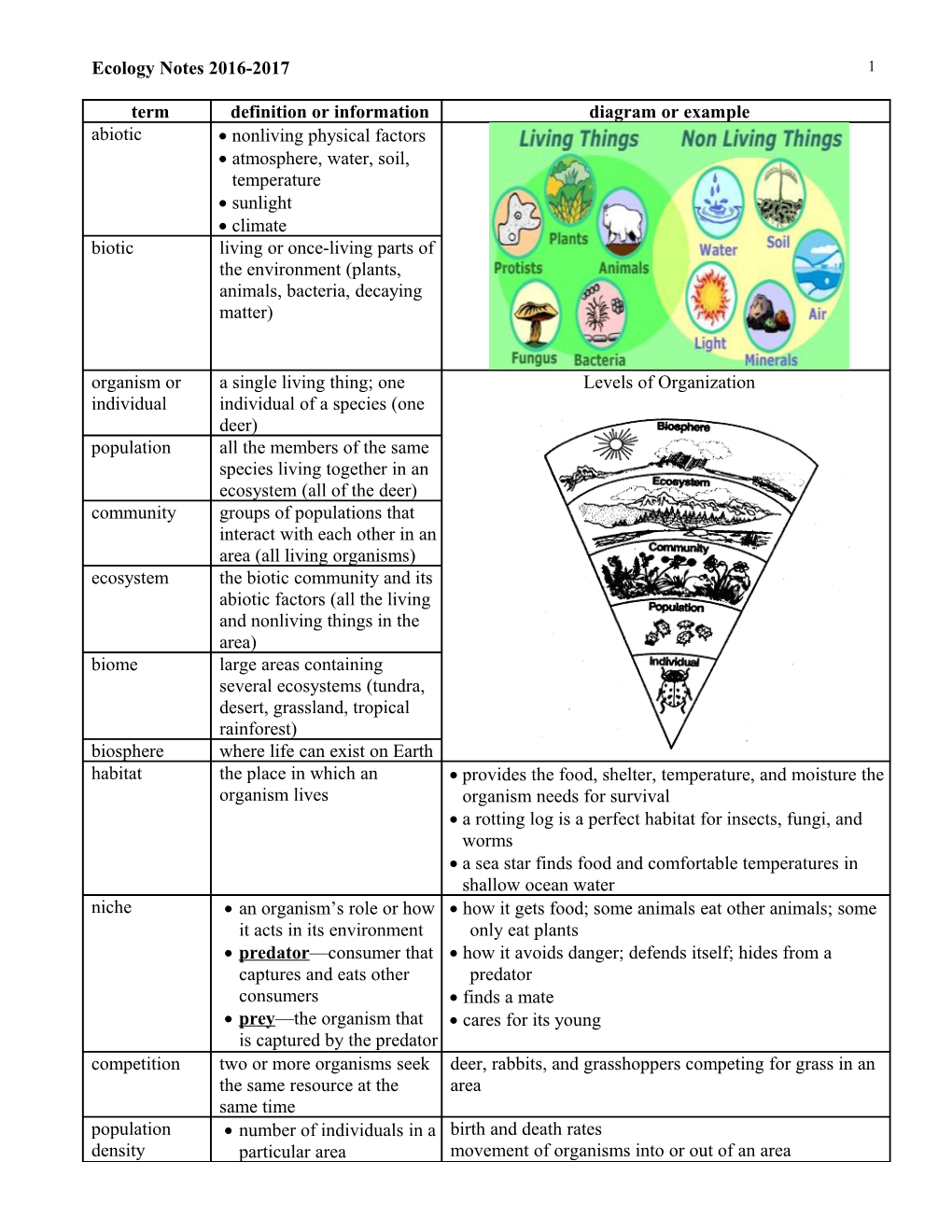1
Ecology Notes 2016-2017
term / definition or information / diagram or exampleabiotic /
- nonliving physical factors
- atmosphere, water, soil, temperature
- sunlight
- climate
biotic / living or once-living parts of the environment (plants, animals, bacteria, decaying matter)
organism or individual / a single living thing; one individual of a species (one deer) / Levels of Organization
population / all the members of the same species living together in an ecosystem (all of the deer)
community / groups of populations that interact with each other in an area (all living organisms)
ecosystem / the biotic community and its abiotic factors (all the living and nonliving things in the area)
biome / large areas containing several ecosystems (tundra, desert, grassland, tropical rainforest)
biosphere / where life can exist on Earth
habitat / the place in which an organism lives /
- provides the food, shelter, temperature, and moisture the organism needs for survival
- a rotting log is a perfect habitat for insects, fungi, and worms
- a sea star finds food and comfortable temperatures in shallow ocean water
niche /
- an organism’s role or how it acts in its environment
- predator—consumer that captures and eats other consumers
- prey—the organism that is captured by the predator
- how it gets food; some animals eat other animals; some only eat plants
- how it avoids danger; defends itself; hides from a predator
- finds a mate
- cares for its young
competition / two or more organisms seek the same resource at the same time / deer, rabbits, and grasshoppers competing for grass in an area
population density /
- number of individuals in a particular area
- population size—indicates whether a population is healthy and growing
movement of organisms into or out of an area
fishing or hunting
carrying capacity / the largest number of individuals of one species that an ecosystem can support / ---based on limited food and limited space
---mast year----highly productive years (example---During certain years, oak trees produce much greater numbers of acorns than usual.)
limiting factor / biotic or abiotic factors that restricts the size of a population / drought
wildfire
deforestation
parasites
biotic potential / the size a population could reach if no limiting factors stopped its growth /
photosynthesis /
- producers (plants, algae) convert light energy to chemical energy
- combine carbon dioxide and water to produce glucose and oxygen
- Cellulose is the substance that makes up most of a plant's cell walls. An increase in the cellulose is an increase in plant size.
6CO2 + 6H2O + energy C6H12O6 + 6O2
chemosynthesis / the production of energy-rich nutrient molecules from chemicals at hydrothermal vents at the bottom of the ocean
---sulfur, hydrogen sulfide, methane, carbon dioxide
---giant tube worms /
biomass / organic material made from plants and animals (microorganisms) / wood, crops, garbage, landfill gas, alcohol fuels,
food chains / shows how matter and energy pass from one organism to another /
food web / shows all the possible feeding relationships among the organisms /
energy flow /
- arrows represent the
- final consumer has the smallest percentage of original energy available
- the first producer has the largest percentage of energy
- arrow points to the organism that eats the previous organism
energy pyramid / shows the amount of energy available at each feeding level in an ecosystem /
trophic level /
- feeding levels
- organisms at each trophic level get energy by feeding on organisms at a lower level
- only about 10% of the energy is passed on to the next trophic level
biological magnification / the increasing concentration of toxic substances within each successive link in the food chain /
- pesticides used by farmers can accumulate in the fat of animals
- the chemical such as DDT or other pollutants move up to higher levels in the chain or web
- DDT is linked to the fragileness of eagle eggs
producers (autotroph or autotrophic) /
- makes its own food using photosynthesis
- sun—source of energy that fuels most life
- plants, many algae, and some bacteria
- most producers use the sun and contain chlorophyll, a chemical required for photosynthesis
consumers (heterotroph or heterotrophic) / cannot make their own energy-rich molecules; they obtain energy by eating other organisms / herbivores---eat plants
carnivores---eat animals
omnivores---eat plants and animals
scavengers---feed on the bodies of dead animals
decomposers / the removal of decomposers would have a big impact on the recycling of nutrients / earthworms, fungi and bacteria eat dead organisms
symbiosis / close interactions between species /
mutualism / both species benefit /
- honey bee and dandelion
- clownfish and anemone
commensalism / helps one species but has no effect on the other /
- American Robin and a Red Maple tree
- cattle egrets and livestock
- shark and remora
parasitism / one species is harmed and the other benefits /
- white-tailed deer and deer tick
- tapeworm inside a pig
invasive species
(alien, foreign,
exotic) / invade foreign lands, where they may thrive, become pests, and threaten native species / kudzu, zebra mussel, purple loosestrife, Giant Asian Carp,
fire ants, Cogon grass, water hyacinth, lionfish
---Burmese and Indian pythons in the Florida Everglades
---Nutria in Louisiana
deforestation /
- clearing of forest lands
- leaves the soil infertile
- contributes to greenhouse effect; soil erosion; extinction of species
conservation /
- preservation of the Earth’s natural resources
conserve renewable and nonrenewable resources
biodiversity / variety of life on Earth
- vital for maintaining stable, healthy, and functioning ecosystems
